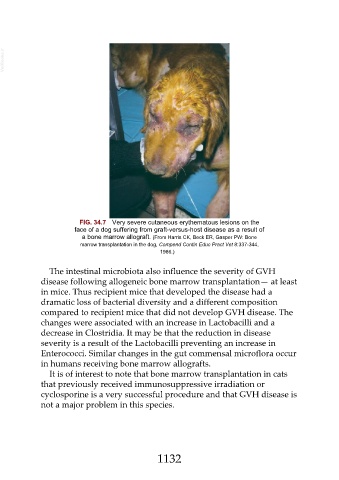Page 1132 - Veterinary Immunology, 10th Edition
P. 1132
VetBooks.ir
FIG. 34.7 Very severe cutaneous erythematous lesions on the
face of a dog suffering from graft-versus-host disease as a result of
a bone marrow allograft. (From Harris CK, Beck ER, Gasper PW: Bone
marrow transplantation in the dog, Compend Contin Educ Pract Vet 8:337-344,
1986.)
The intestinal microbiota also influence the severity of GVH
disease following allogeneic bone marrow transplantation— at least
in mice. Thus recipient mice that developed the disease had a
dramatic loss of bacterial diversity and a different composition
compared to recipient mice that did not develop GVH disease. The
changes were associated with an increase in Lactobacilli and a
decrease in Clostridia. It may be that the reduction in disease
severity is a result of the Lactobacilli preventing an increase in
Enterococci. Similar changes in the gut commensal microflora occur
in humans receiving bone marrow allografts.
It is of interest to note that bone marrow transplantation in cats
that previously received immunosuppressive irradiation or
cyclosporine is a very successful procedure and that GVH disease is
not a major problem in this species.
1132

